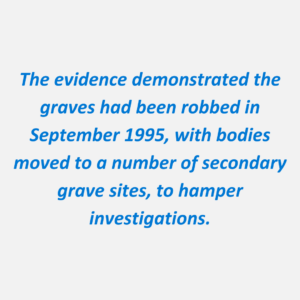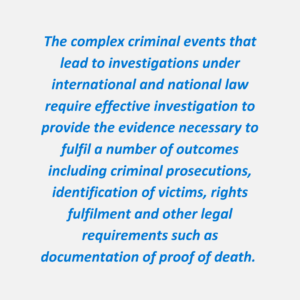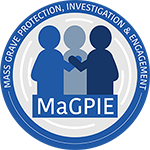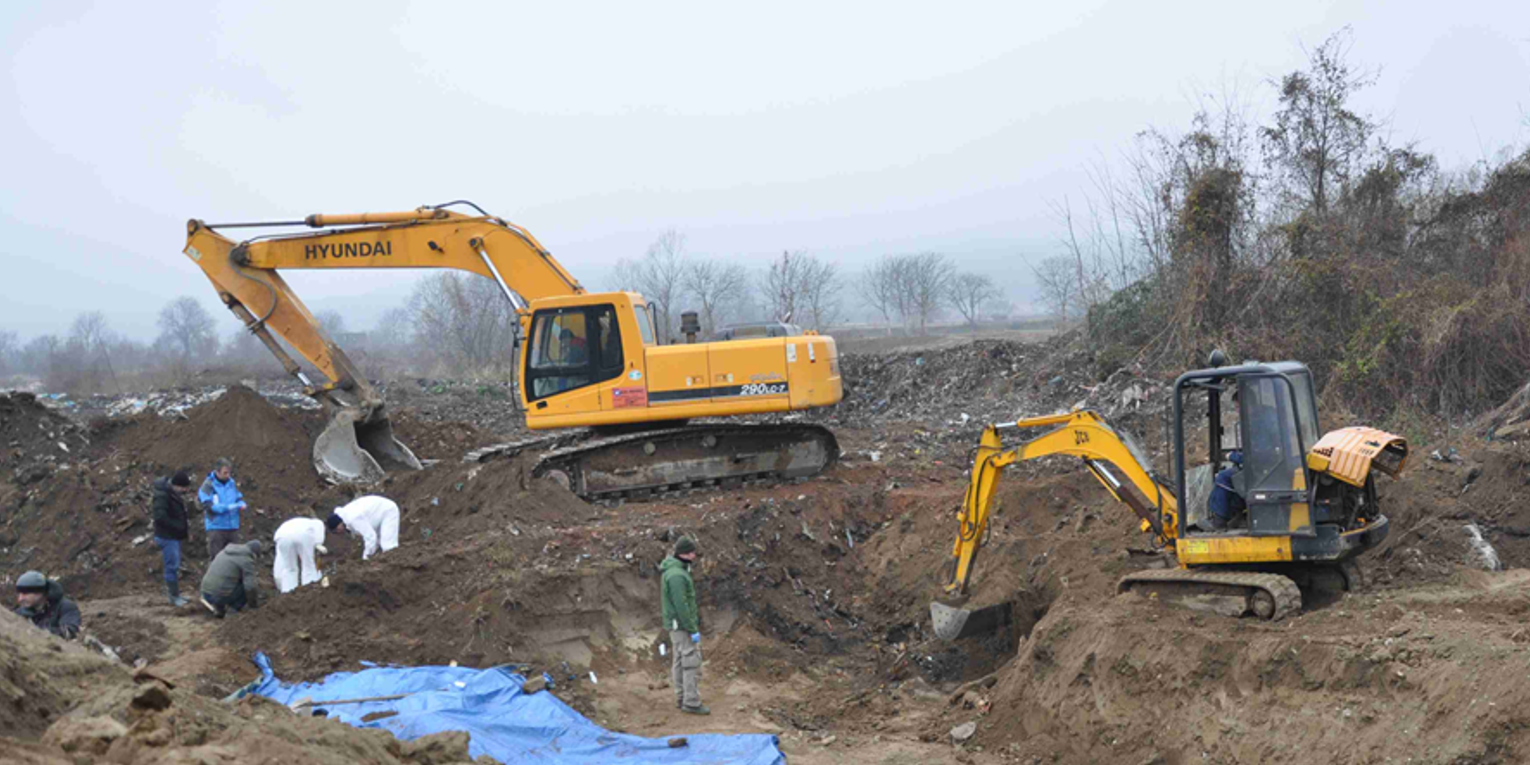“I have two bones of my son. That’s all I had to bury … perhaps we can find more of the missing men here.”
In October 2015, Munira Subaric and Kada Hotic of the Association of Women of Srebrenica and Zepa, stood at a rubbish dump on the bank of the river Drina outside the town of Kozluk in Eastern Bosnia-Herzegovina (BiH). Here, in July 1995, more than 860 men and boys captured after the fall of Srebrenica were executed and buried in mass graves. The International Criminal Tribunal for the Former Yugoslavia (ICTY) had undertaken excavations here in 1999 and revealed evidence of the massacre and recovered the remains of several hundred victims. The evidence demonstrated the graves had been robbed in September 1995, with bodies moved to a number of secondary grave sites, to hamper investigations. Excavation retrieved dating, ballistics, botanical, toolmark, binding, restraint, anatomical position and identification evidence. Remains were examined to determine cause and manner of death, and nearly all were identified over time through DNA matching analysis. A total of 863 DNA profiles associated to the Kozluk execution and burials had been recorded by 2016.[1]
investigations. Excavation retrieved dating, ballistics, botanical, toolmark, binding, restraint, anatomical position and identification evidence. Remains were examined to determine cause and manner of death, and nearly all were identified over time through DNA matching analysis. A total of 863 DNA profiles associated to the Kozluk execution and burials had been recorded by 2016.[1]
We had come to Kozluk, now much changed by river erosion, burning heaps of rubbish and overgrown with trees, because Munira had information from a witness. “I met a man in a restaurant in Kozluk. He said he had information there was another mass grave at the site. The knowledge of this was on his conscience.”
This witness information added to that already gathered in a renewed assessment of the Kozluk site, undertaken in 2014-2015. The efforts to find more of the missing in BiH had led to a review of the combined evidence from known sites and cases in BIH by the International Commission on Missing Persons (ICMP), coordinating with newly formed working groups of stakeholders in BiH, including the Missing Persons Institute (MPI), State Prosecutor, State Police, PIP Forensic Centre Tuzla, Republica Srpska Forensic Centre, ICTY, the International Red Cross (ICRC) and the Embassies of the United States and the United Kingdom. Aerial imagery analysis of the Kozluk site dating to July 1995 pinpointed areas of disturbed ground that had not been excavated in 1999. Assessment of excavation survey data from the primary graves at Kozluk and related secondary graves revealed a deficit in volume of material, indicative of another primary grave might exist. Assessment of the cases of remains and related DNA matching data indicated a number of body parts were missing, suggesting they might be in an as yet undiscovered grave. Information gathering by the State prosecutor agreed with these conclusions. The combined analysis provided enough evidence for the prosecutor to secure a court order for a new excavation.
The site assessment with Munira, Kada and MPI helped pinpoint areas to search. Excavation started on 4th December 2015, with a grave found on the 5th December. Two weeks of excavation revealed a combined execution site and mass grave that, like the other graves found at the site, had been robbed. A total of 55 cases of bodies and body parts were recovered, that upon anthropological assessment and DNA analysis were revealed to contain the remains of 65 individuals.
The excavation coincided with arrest on 30th November 2015 of Srecko Acimovic, a wartime Bosnian Serb Army battalion commander whose troops imprisoned and executed the Kozluk victims. He was found guilty in the BiH state court on 16th October 2020 of aiding genocide, sentenced in 2021 after appeal to 7 years in prison.[1] The evidence gathered prior to 2015 was also utilised in a number of successful war crimes trials at ICTY including Krstic, Tolimir, Karadzic and Mladic.[2] The Women of Srebrenica came to the excavation in December 2015 to witness the recovery of their missing men.[3]
The Kozluk excavation exemplifies the range and nature of evidence that can be gathered and utilised from mass graves and other atrocity crime scenes, collated from a breadth of contributors. This has been studied in detail at the outset of the MaGPIE project to provide a benchmark case study for assessing the potential of data collected from other mass grave investigations.
The project has also defined the process of the scientific investigation of mass graves, based on developed effective practice, with the Kozluk excavation assessment contributing. This has allowed a definition of ‘effective investigation’ to be summarised,[4] that is being used to measure and compare
against country specific examples of mass grave investigation to assess their effectiveness. Review of all country studies will provide an inclusive definition that will inform stakeholders and future investigations.
The complex criminal events that lead to investigations under international and national law require effective investigation to provide the evidence necessary to fulfil a number of outcomes including criminal prosecutions, identification of victims, rights fulfilment and other legal requirements such as documentation of proof of death. Atrocity crimes include mass murder, persecution, abduction, disappearance, sexual crimes, torture and the destruction of individuals, groups and cultural and historic heritage. The events are often manifestations  of multiple crimes, multiple crime scenes, multiple victims and multiple perpetrators. Events are often linked. Such complexity requires investigations that are detailed, encompassing, efficient, impartial and inclusive, based on the breadth of current forensic and scientific practice.
of multiple crimes, multiple crime scenes, multiple victims and multiple perpetrators. Events are often linked. Such complexity requires investigations that are detailed, encompassing, efficient, impartial and inclusive, based on the breadth of current forensic and scientific practice.
Each investigation of mass graves is always intricate. Multiple dead and multiple legal considerations require multidisciplinary teamwork. In organisational terms, the examination and processing of a mass grave combines the attributes of major incident crime scenes, complex archaeological rescue excavation, and mass disaster victim triage and identification procedures.
By defining effective practice, the project will assist the understanding of, and appreciation for, the potential for processes that can be deployed and are required to gather evidence of atrocity crimes. This will also inform how that evidence can be utilised, exemplify how legal and rights requirements of investigations can be met, and demonstrate the intent of investigations to fulfil those requirements.
Dr Ian Hanson
_________________________________________________________________________________________________________________________________________________
[1] See Balkan Transitional Justice, ‘Bosnia Jails Serb Ex-Officer for Aiding Srebrenica Genocide’ (02 September 2021) https://balkaninsight.com/2021/09/02/bosnia-jails-serb-ex-officer-for-aiding-srebrenica-genocide/
[2] See for example, Prosecutor v Mladić [22 November 2017] Judgment, Volume III of V,
IT-09-02-T-115803-115787. https://www.icty.org/x/cases/mladic/tjug/en/171122-3of5_1.pdf
[3] See Reuters Pictures, ‘Another Srebrenica mass grave unearthed’ (15 December, 2015) https://www.reuters.com/news/picture/another-srebrenica-mass-grave-unearthed-idUSRTX1YSR2
[4] Under international law, for example article 15 of the International Convention for the Protection of all Persons from Enforced Disappearance, ‘effective investigation’ is a requirement, but had not been formerly defined.
[1] See Anatomy of a grave: the Kozluk excavations as an exemplar of a successful mass grave investigation https://www.elgaronline.com/edcollchap/book/9781800882386/book-part-9781800882386-10.xml







